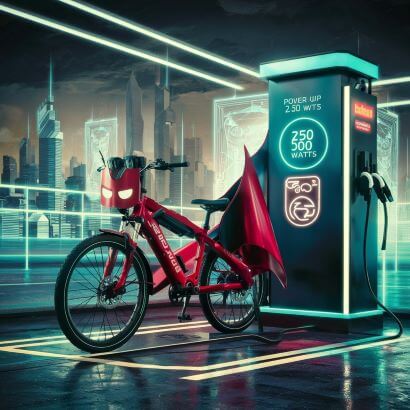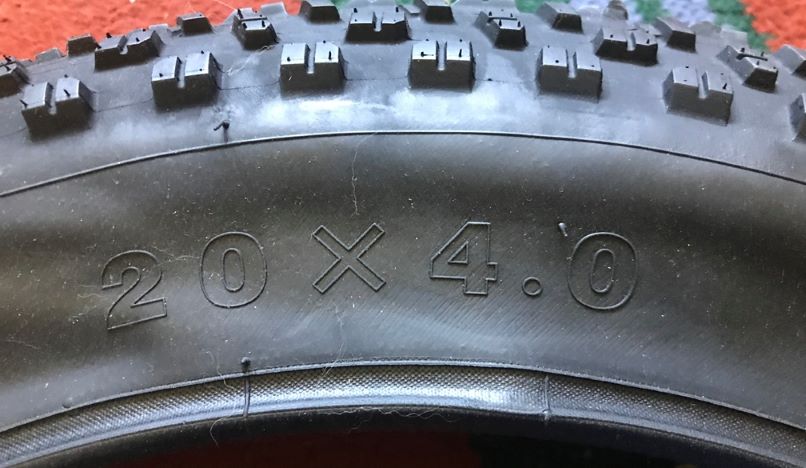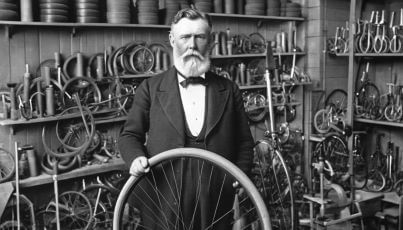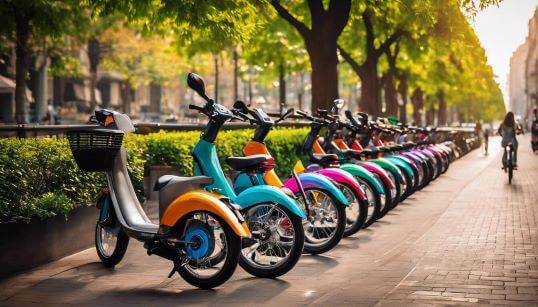Big news in the world of UK e-bikes, and it’s about to get a whole lot bigger! We’re potentially saying Cheerio to the humble 250-watt limit and rolling out the red carpet for a zippy 500 watts. Yes, that’s double the power, folks! Imagine your bike just gulped down an energy drink. And there’s more – throttle-powered e-bikes could soon be joining the party, offering a smoother cruise for everyone, especially for those who think pedalling is a bit of a chore. It’s like your bike’s been given a pair of rocket boots!
But, let’s not get ahead of ourselves – it’s not all high-speed thrills and wind in your hair. With great power comes great responsibility, and there’s a fair bit of head-scratching over the safety of these speedy gizmos. Are we ready to zoom into this bold new electric future? Or are we opening a can of worms where the worms are all wearing tiny helmets? Stay tuned as we navigate these exciting, yet uncharted, electric avenues!

Here are the Key points
You can find the full report online or use the link at the bottom of the page on the Government website, I do not know how involved other parts like the Department for Transport are, but cyclists all over England will be hoping for some success of this proposal because their adoption of the electric bicycle has been too slow.
- Proposed Changes: The government proposes to increase the power limit of EAPCs to 500 watts from 250 watts and allow throttle assistance up to 15.5mph without needing type approval.
- Benefits: The agenda aims to improve health, reduce emissions, cut traffic and congestion, and enhance the attractiveness of local areas.
- Investment and Active Travel England: Over £3 billion is projected for investment up to 2025. A new executive agency, Active Travel England, has been created to work with local authorities on this program.
- Electrically Assisted Pedal Cycles (EAPCs): EAPCs are seen as crucial to increasing cycling levels. They offer easier cycling over longer distances and on hills, benefiting older individuals, and those with disabilities, or mobility impairments.
- E-Cargo Bikes: These are used for transporting goods more efficiently, reducing congestion and improving air quality. The government has provided funding for e-cargo bike grants.
- Current Regulations on EAPCs: Regulations from 2015 define EAPCs as cycles fitted with pedals, a motor of no more than 250 watts, and electrical assistance cutting off at 15.5mph. EAPCs are not considered motor vehicles and are exempt from registration, road tax, and motor vehicle insurance but cannot be ridden by those under 14.
- Throttle Assistance: EAPCs with throttle assistance (twist and go) require type approval if the assistance is above 3.73mph.
- Active Travel Agenda: This is part of the government’s Smarter Regulation Programme aimed at reducing regulation burdens and promoting economic growth. The goal is to make walking, wheeling, and cycling the primary choices for shorter journeys, aiming for half of all short journeys in towns and cities to be done this way by 2030. This aligns with the government’s second cycling and walking investment strategy.
- Rationale for Changes: The changes aim to make EAPCs more appealing and usable, especially for navigating hills and gradients, and to assist disabled people, older individuals, and those transporting goods.
- Potential Issues: Concerns include increased risks of collisions and injuries, especially with more powerful e-cargo bikes, and potential safety risks from more powerful EAPCs.
- Consultation Process: The document invites stakeholder opinions and evidence on the proposed changes. The consultation began on February 29, 2024, and will run until April 25, 2024.
- Specific Questions for Stakeholders: The consultation seeks feedback on various aspects, including the impact of proposed changes on safety, market dynamics, consumer behaviour, small businesses, disabled people, and e-cargo bike users.
I think this is a good thing, but I think they should have made it 750 watts and changed the speed limit to 20mph, as there is little reason to keep it at 15.5mph, many people say it is too slow.
New Speed and Motor Power Regulations
The proposed regulations signal a significant shift in the capabilities of electric bikes. Presently, electric bicycles are limited to a maximum continuous rated power of 250 watts. Yet, if the new regulations pass, this limit could double to 500 watts. Essentially, e bikes would be able to provide more power, making it easier to tackle challenging terrain or carry heavier loads with less effort. This change has the potential to appeal to a wider audience, including individuals who may require additional assistance for various reasons.
On top of the increased motor power, the proposed changes would also allow Electrically Assisted Pedal Cycles (EAPCs) to have throttle assistance up to 15.5mph without type approval. This means that riders can receive assistance from the motor without having to pedal and still reach 15.5mph, expanding the convenience and accessibility of e-bikes. It is important to note that the current limit for assisted speeds is also 15.5mph; however, riders typically need to pedal to attain this speed. The adjustment may enhance inclusivity by accommodating individuals with varying physical abilities.
Imagine a commuter facing a steep incline on their way to work or a cyclist who needs a little extra help due to health concerns or other reasons – these changes could make a significant difference in their comfort and ability to cycle safely.
It’s worth considering how these changes may impact the perception of e-bikes as well. A broader range of options and increased power could attract more people to consider electric bikes as a viable mode of transportation. The possibility of reaching higher speeds and handling more demanding terrain could elevate e-bikes from recreational use to practical and reliable alternatives for daily commuting and errands.
The potential advancements in motor power and permissible speeds are poised to transform the landscape of e-bike usage, offering enhanced accessibility and usability.
The Future of Pedal-Assist and Motor Rules
The proposed changes are poised to bring about a significant shift in the way we interact with and use electric bikes. One of the most notable developments is the allowance for throttle assistance up to 15.5mph without requiring type approval. This means that riders will have the freedom to benefit from automatic power assistance up to a certain speed without the obligatory need for pedalling.
With this shift, e-bikes become more inclusive, offering accessibility and versatility to a broader range of users. The potential impact of this change is substantial, as it opens doors for individuals who may have previously felt excluded due to physical limitations or other factors. This increased inclusivity aligns with the overarching goal of promoting sustainable and accessible transportation options.
Moreover, from a practical standpoint, this change acknowledges the evolving needs and preferences of riders, allowing for a more diverse and adaptable e-bike experience. By offering greater flexibility in how power assistance is utilised, riders can tailor their e-bike usage to suit their individual circumstances and preferences.
This shift also underscores the ongoing efforts to harmonise regulations across different regions, which contributes to creating a more uniform framework that supports the widespread adoption of e-bikes. Establishing a cohesive set of rules and standards can provide clarity for manufacturers, retailers, and users, fostering a supportive environment for the growth of e-bike infrastructure.
As the landscape of pedal-assist and motor rules continues to evolve, it’s essential to explore the implications of these changes on user experience, accessibility, and broader transportation initiatives.
There was no mention of making
When will this happen?
You know, trying to keep up with the UK government’s pace on electric vehicles is like watching paint dry in slow motion. Remember the electric scooter saga? We were all on the edge of our seats, thinking, ‘Here we go, they’re gonna change the law!’ But nope, not a peep since. Meanwhile, everyone’s zipping around on their scooters and those dodgy ebikes, just giving the law the old cheeky wink and carrying on!
It says there is some kind of review of the finding before this proposal is even close to being close to any kind of enforcement.
It is a shame there is little planning for the infrastructure of e-bikes and even things like disposing of ebike batteries there seems to be little thought about this whole industry of cycling.
References
See Also
Everything You Need to Know About UK Law and Electric Bikes: A Comprehensive Guide
Electric Scooter Law in the UK
Delay in EScooter law
I'm the passionate mind behind this online web shop. As an avid cyclist, I have a particular fondness for electric bikes and scooters, believing they offer a unique sense of freedom and joy. Not only do I enjoy riding them, but I also take pride in reviewing and sharing my insights about these fantastic machines. Additionally, as someone who suffers from dry eyes, I'm committed to stocking products that genuinely enhance and improve people's lives. Dive into my shop, and you'll find a curated selection of e-bikes, scooters, and other life-enhancing products that I stand by.






